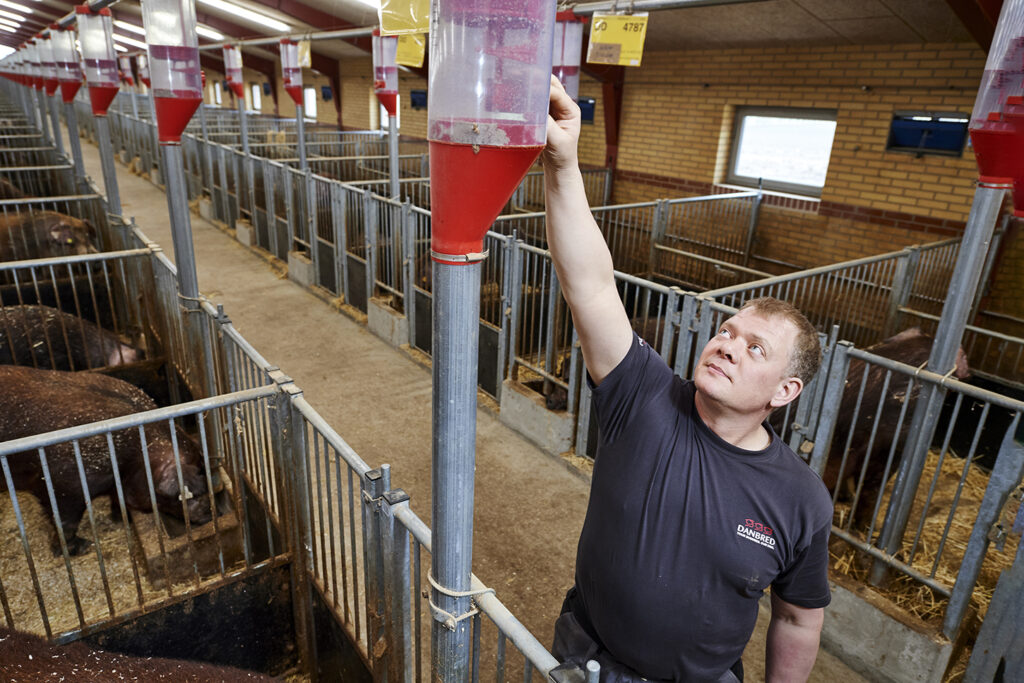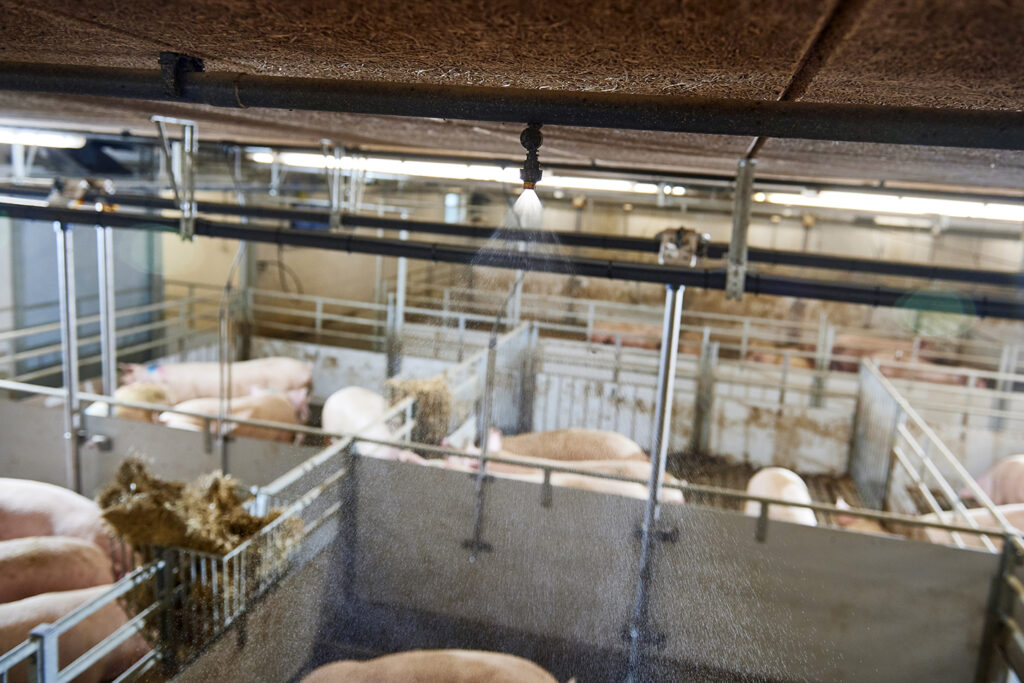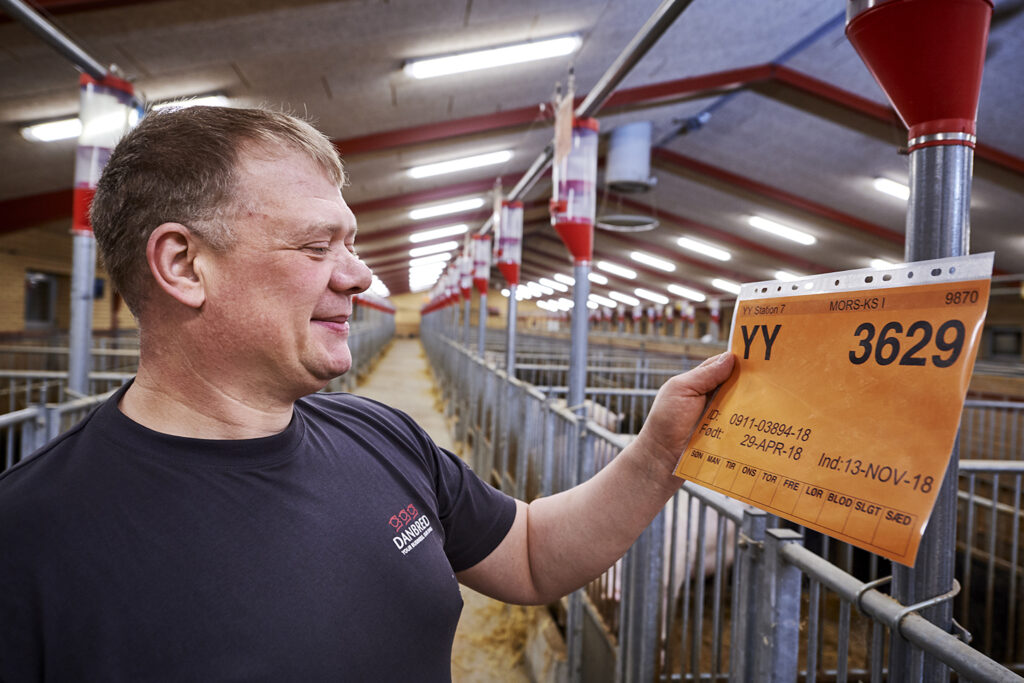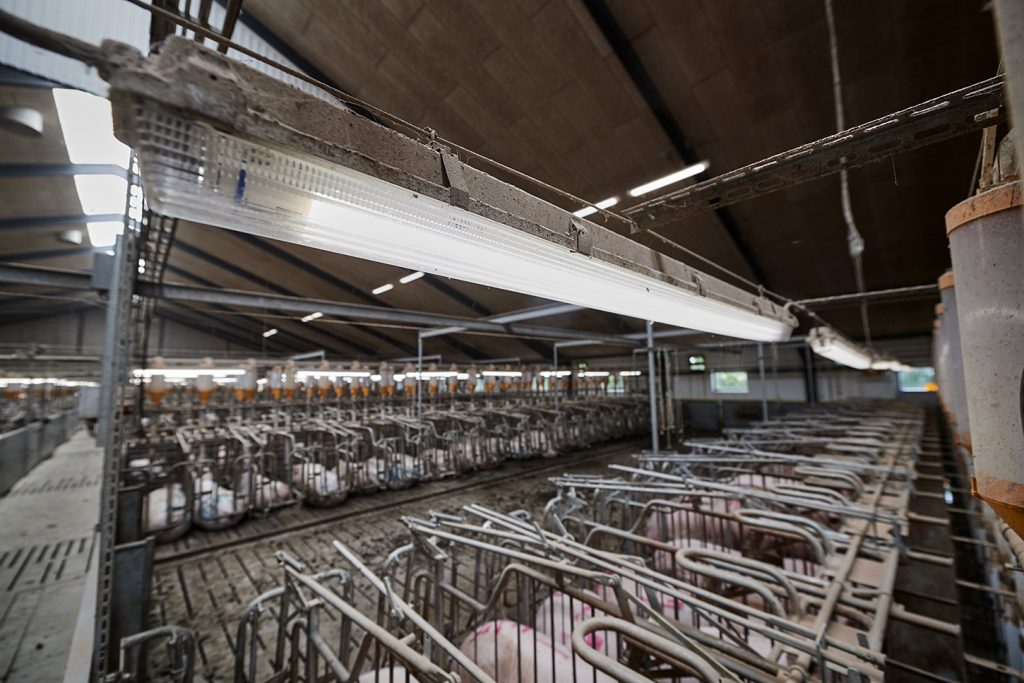Boar unit
DanBred boars are high-quality, performance-tested animals. The management and housing facilities should match the quality of the boars in order to release their full genetic potential.

Plan the transfer – preparation of the pens
At the end of quarantine, the boars are ready for transfer to the boar unit. We recommend using a closed filtered truck to transport the boars so they maintain their standard of health during the move.

To help achieve a smooth transition for the new DanBred boars, we recommend moving the boars into the boar unit one pen at a time in the same groups that they were in during quarantine. This will maintain social ranking among the boars and promote a calm transition.
 |
 |
Individual pens are recommended for boars above 4,5 – 5 months. At a younger age, the boars can be housed in groups. If circumstances prevent following this recommendation, individual housing must happen no later than 14 days prior to their first training day.

Individual housing will minimize injuries from fighting in group pens – individual housing should however allow visual and physical contact for the boars. Prior to the move, make sure that all preparations have been made and that the pens are ready to receive the boars.
- Plan the transport – remember to order transport if an external partner is used
- Prepare the pens in the boar unit
- A boar pen for fully mature boars should be min 6 m2
(If the pen is used for natural insemination it requires 10 m2)
- A boar pen for fully mature boars should be min 6 m2

- The floor in the pens must be nonslip to avoid accidental damage during training
|
|
|
- Drinkers in the pens should provide at least 4 L/min.
- The boars should always be able to make visual contact with other boars in the surrounding pens.
- This will ensure visual experience from the other boars, and make sure that they are able to learn from one another.
- It will also help evolve libido and dominance in the boars which will enhance their performance later on
|
|
|
- Make sure that young boars are not placed with older, dominant boars as this can suppress their sexual behaviour and their ability to be trained.
- All boars should have permanent access to straw or other natural materials
|
|
|
When the boars have been placed in the pens, register each individual. Afterwards, you can print copies of the management programme to document the boars’ progress and ensure proper registration. Charts should have as much information on each boar as possible, and always include the boar’s name (for example YY3629), its age and DanBred ID no.
|
|
|
Continued targeted feeding
New boars are usually of different ages when they are moved to the boar unit. It is important to adapt the feeding levels to the age of each boar to ensure optimum growth before the first production of semen.
Feeding the boars in the boar unit should follow the same recommendations as in the quarantine unit, but of course taking the age and weight of the boars into account. The recommended feed curve shown below is the primary indicator for feeding in the boar unit, combined with the composition of feed as mentioned earlier.

However, the use of the boars should also be a factor for consideration. When the boars begin their training, feeding should be based on body condition, age and weight.
| Weight Kg | Daily feed amount | Energy density per kg of feed |
|---|---|---|
| 110 => | 2.5-3.2 kg per day (Average 2.9 kg per day) | 1.05 EW / 12.5 MJ ME / 9.7 MJ NE |
Feeding boars in use
Feeding active boars in use should take weight and age into consideration, and the feed should be consistent with the feed composition for dry sows. It is important to make sure that vitamins and minerals also match these recommendations to ensure optimal reproduction results. The amount of digestible fibres in the feed compounds is of major importance in terms of gastric health and satiety with the boars, to promote longevity as well as behaviour that is calm and easy to handle.
|
|
|
Make sure to follow the recommendations below for boars in use. The numbers are based on the composition of feed for sows in the mating unit.
| Restricted feeding | Boars 65-110 kg1 | Boars > 110 kg1 | Boars in use |
|---|---|---|---|
| Energy density per kg feed | 9.5 MJ NE/12.5 MJ ME/1.05 EW | 9.8 MJ NE/13.0 MJ ME/1.06 EW | |
| SID Lysine per kg feed (g) | 5.3 | 5.3 | |
| Total lysin per kg feed (g) | 6.9 | 6.5 | |
| Minimum SID crude protein per kg (g) | 100 | 100 | |
| Phosphorous per kg (g)² | 4.4 | 4.4 | |
| Digestible phosphorus per kg (g)² | 2.4 | 2.4 | |
| Calcium per kg (g) | 6.8 | 6.8 | |
¹ This is also recommended for the boar unit – before and after the boar is taken into use
² Based on usage of phytase
*NE = Net energy; ME = Metabolic Energy; EW= Net Energy using the Dutch evaluation system
Boars should be fed high-quality diets which include at least 5% dietary fibre. We recommend sugar beet pellets combined with oats (0-15%) and barley (preferably >35% barley) or similar high-quality fibres available locally.
Boars thrive on coarsely ground meal or expanded feed. If only pellets are available, use an additional 10-15% of non-heat-treated, roller-milled barley to make a coarser composition and ensure longevity.
Feeding based on body condition score
When feeding the boars in use, body condition is a main indicator for the recommended feed curves.
You can use different methods to evaluate body condition:
- Visual evaluation – simply look at each boar

- Physical evaluation – use your hands to check the body

- Measurement of the backfat thickness.
|
|
|
We recommend using a combination of methods to assess body condition. Never rely on visual evaluation alone.
On average, aim at having as many boars as possible with an average body condition – a backfat thickness of 7-8 mm. Do a body condition evaluation on the first day of training, repeat the evaluation before taking the boar into production and follow its development every two months. The evaluation before training will help in choosing the correct feeding curve for each boar during use. Subsequent evaluations will show whether or not you need to make any adjustments to the feeding curve.

Individual feed adjustments
Adjustments to the feed rations should be made by the same person every day to make sure each boar gets the optimal rations.
- Empty all feed troughs before feeding.
|
|
|
Check that all boars get up and start eating when feeding begins.
 |
 |
- Boars should finish eating 30 minutes after feeding. Check this at least once a day but always at the same time every day
- If boars do not eat the full ration, adjust the feed ration or skip a feed
 |
 |
- After the boars finish eating, empty all the feed troughs and make sure all the boars have access to clean water
|
|
|
Number of feedings per day:
- We recommend feeding the boars once or twice a day
- Feeding times could be:
- 05:00 – 08:00
- 15:00 – 16:00
- and/or 19:00 – 21:00
- In hot climates, or in a spell of warm weather, we recommend feeding during the colder hours.
Recommended boar unit layout
Housing of the boars should be designed to promote the quality of each animal and optimise semen production. It should be made from materials that are heavier than those for housing sows – so they take the greater size and strength of boars into consideration.
Light
The recommended minimum light level is 100 LUX at boar-eye level 16 hours a day. Make sure all light sources are clean and produce the recommended amount of light. Be aware of any dark corners in the boar unit. Natural light will produce a high amount of lux, but it is very sensitive to dirt on walls and windows. So, it is a good idea to keep walls clean and paint them white.
|
|
|
Climate
The optimal ambient temperature for semen production is 18-20 °C. Boars, however, can tolerate a higher ambient temperature if good ventilation is provided. Water sprinklers or foggers can also be used, to help the boars stay cool and comfortable. Dampening an area of concrete floor for the boars to lie on will also help keep them cool, but be aware that a wet environment can compromise hygiene.
 |
 |
Semen quality can be affected if the ambient temperature exceeds 25°C, and the effect can last up to eight weeks after exposure. It is a good idea to record the maximum and minimum ambient temperature in the boar unit every day and save the records in case you need to analyse semen quality variation at some point in the future.
 |
 |















